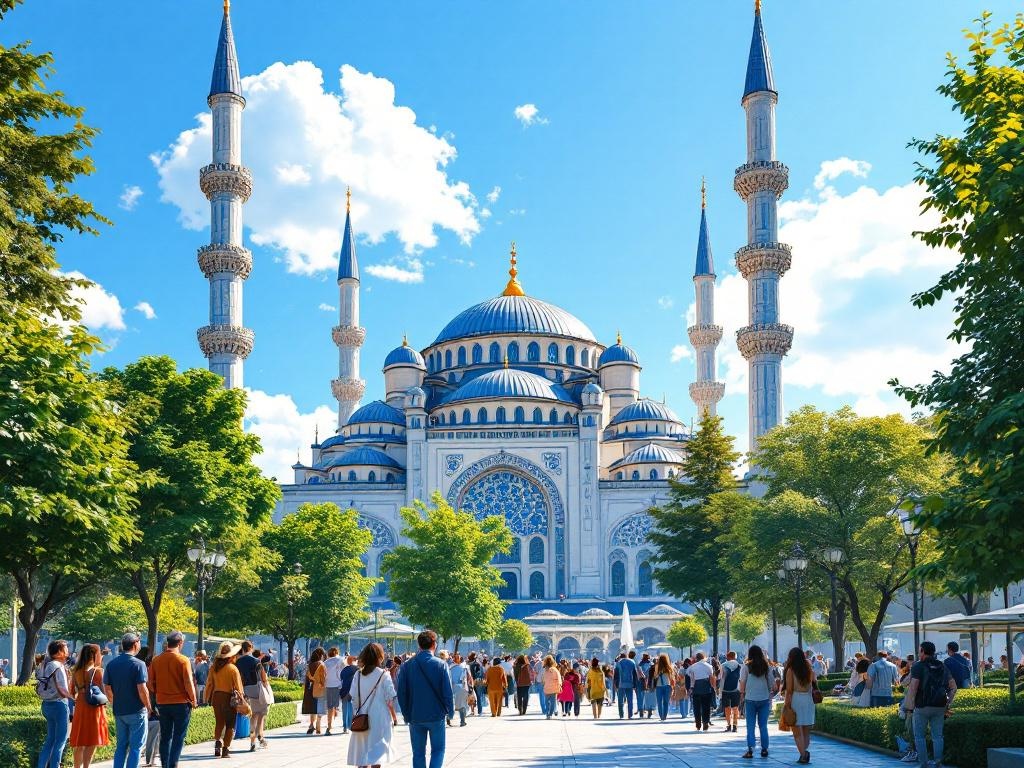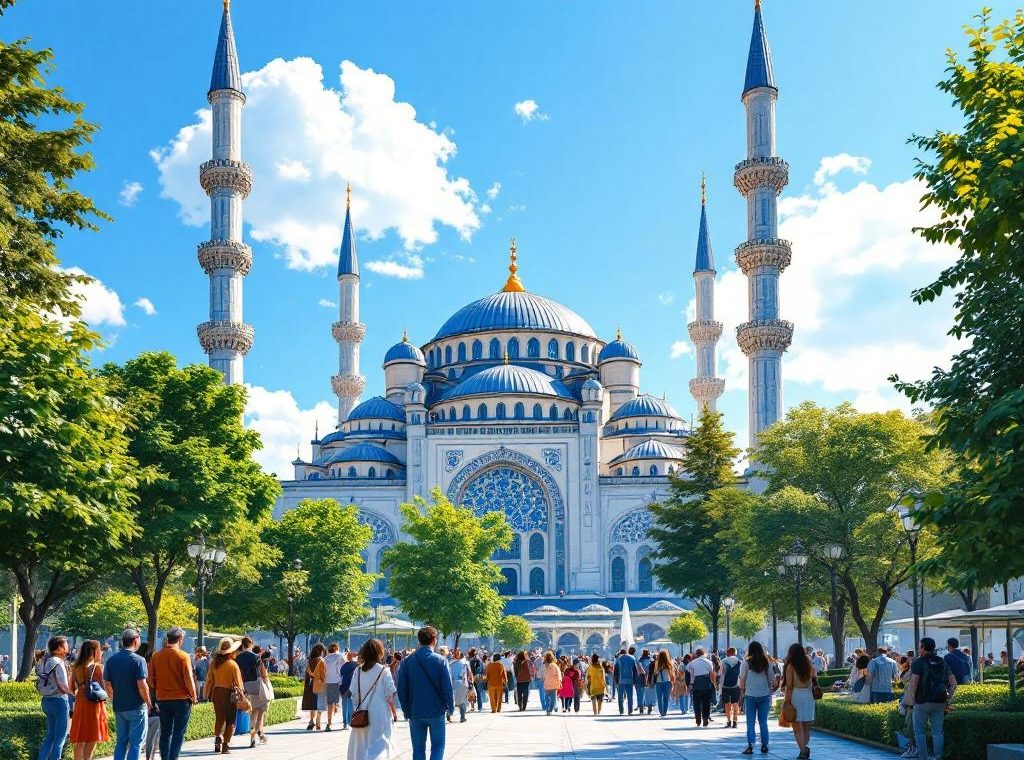Discovering the Blue Mosque in Istanbul
Journey to Istanbul’s heart and discover the breathtaking Blue Mosque, a testament to Ottoman architectural brilliance. Built to rival the Hagia Sophia, this 17th-century marvel features stunning blue Iznik tiles, six towering minarets, and a captivating blend of Byzantine and Islamic design. Explore its rich history, from its commissioning by Sultan Ahmed I to its modern-day significance as a UNESCO World Heritage Site. Discover practical tips for planning your visit, including the best times to avoid crowds, transportation options, and nearby attractions. Uncover the magic of the Blue Mosque – start planning your unforgettable experience today!
Important information

- Built between 1609 and 1617 by Sultan Ahmed I, the Blue Mosque showcases a blend of Ottoman and Byzantine architecture.
- Its interior features over 20,000 handmade Iznik tiles, creating a stunning blue mosaic.
- The mosque is an active place of worship; visitors should dress modestly (covering shoulders and knees) and respect prayer times.
- Located in Istanbul’s Sultanahmet district, it’s easily accessible by tram and near other historical sites like Hagia Sophia.
- Designated a UNESCO World Heritage Site, the Blue Mosque represents a significant cultural and historical landmark.
Historical Background of the Blue Mosque
Istanbul’s majestic Sultan Ahmet Camii, or Blue Mosque, stands as a testament to Ottoman architectural ingenuity. Built between 1609 and 1617 during Sultan Ahmed I’s reign, this imperial mosque beautifully marries Islamic and Byzantine design elements. Commissioned by the sultan to rival the Hagia Sophia, it symbolized the empire’s zenith of power and religious fervor. The mosque’s construction marked a pivotal moment in Ottoman history, showcasing the era’s artistic and architectural prowess. Having witnessed the empire’s decline and the subsequent rise of the Republic of Turkey, the Blue Mosque remains a powerful symbol, serving as both an active place of worship and a significant historical landmark.
Construction and Patronage
Sultan Ahmed I commissioned the Blue Mosque. Remarkably, its construction took place between 1609 and 1617, a mere eight years.
Architectural Influence and Design
Istanbul’s Blue Mosque is a breathtaking example of Byzantine and classic Ottoman architectural styles, designed by Sedefkâr Mehmed Ağa, a student of the famed architect Mimar Sinan.
Significance of the Sultan Ahmet Camii
The iconic Blue Mosque in Istanbul, officially the Sultan Ahmet Camii, is a testament to Ottoman architectural brilliance. Constructed during Sultan Ahmet I’s reign, it reflects the empire’s ambition and remarkable artistry. The mosque’s design seamlessly blends Byzantine and Ottoman elements, most notably its stunning blue Iznik tiles. This fusion contributes to its immense cultural importance. The Blue Mosque remains a vital religious center and a powerful symbol of Istanbul’s rich heritage, attracting millions of visitors annually. Its recognition as a UNESCO World Heritage Site further emphasizes its global significance.
Architectural Marvel of the Blue Mosque
The Blue Mosque is an architectural marvel, seamlessly blending Ottoman and Islamic design. Its central dome, encircled by four semi-domes, dominates the Istanbul skyline. Six minarets ascend towards the heavens, while impressive elephant foot pillars provide a sturdy foundation. Inside, the mosque is simply breathtaking. Over 20,000 handmade Iznik tiles adorn the walls, their vibrant blue hues creating a stunning visual display. This artistry is further enhanced by intricate calligraphy and stained glass windows that bathe the interior in a soft, ethereal glow. Byzantine influences are also woven into the mosque’s design, resulting in a unique and harmonious fusion of styles.
Ottoman and Islamic Architectural Styles
The Blue Mosque is a stunning example of Byzantine and Islamic architectural fusion. Its cascading domes create a breathtaking visual, with a central dome encircled by progressively smaller semi-domes. Inside, over 20,000 handmade Iznik tiles form a vibrant blue mosaic, their varied shades a defining feature. Intricate calligraphy and stained-glass windows further enrich the mosque’s awe-inspiring beauty, making it a true architectural masterpiece.
Central Dome and Semi-Domes
Four colossal, elephant-foot pillars uphold the central dome, which is encircled by four semi-domes. This architectural arrangement creates a sense of grandeur and spaciousness within the mosque.
Six Minarets and Elephant Foot Pillars
Four colossal, elephant-foot pillars support the Blue Mosque. Its six minarets are a striking feature of the Istanbul skyline. Inside, exquisite blue Iznik tiles adorn the mosque’s interior.
Iznik Tiles and Interior Tile Work
The Blue Mosque’s interior is breathtaking, adorned with over 20,000 handmade Iznik tiles. These intricately detailed tiles feature:
- twisting floral patterns,
- geometric designs that create a sense of harmony,
- elegant calligraphic inscriptions.
The vibrant shades of blue, green, and turquoise give the mosque its well-known moniker.
Cultural and Religious Significance
The Blue Mosque, a vibrant center of prayer in Istanbul, stands as a testament to the Ottoman Empire’s architectural and artistic brilliance. This magnificent structure, a designated UNESCO World Heritage Site, represents a vital piece of Istanbul’s cultural heritage and holds global significance as a historical and cultural landmark.
The Mosque as a Functioning House of Worship
The Blue Mosque (Sultanahmet Camii) welcomes visitors to explore its beauty outside of daily prayer times.
Role in Istanbul’s Cultural Heritage
The Blue Mosque stands as a vital symbol of Istanbul’s cultural heritage, serving as both an active mosque and a prominent tourist destination. Its stunning domes and renowned blue tiles exemplify the splendor of Ottoman architecture, merging Byzantine and Islamic elements to reflect Istanbul’s vibrant and diverse past. Millions of visitors each year contribute substantially to the city’s tourism and cultural preservation efforts, underscoring the mosque’s historical and spiritual significance.
UNESCO World Heritage Site Designation
The Blue Mosque achieved UNESCO World Heritage Site status in 1985, solidifying its place as a historically and culturally significant landmark.
Planning Your Visit to the Blue Mosque
Plan your Blue Mosque visit for a weekday to enjoy a more peaceful experience with fewer crowds. For optimal lighting and a less crowded atmosphere, visit in the early morning or late afternoon. Remember to check the mosque’s prayer schedule beforehand, as it closes to tourists during these times. This will ensure a smooth and uninterrupted visit. Before you travel, make sure you have the necessary visa or permits. Check the latest entry requirements here: Verify travel entry requirements before you go
Best Time to Visit and Avoid Crowds
Visit the Blue Mosque early in the morning or later in the afternoon to escape the crowds. For a more serene experience, consider visiting during the quieter off-season. Late fall or winter offers a tranquil atmosphere. Remember that the mosque is closed during prayer times.
Transportation Options to Sultanahmet Square
You can easily reach Sultanahmet Square by taking the T1 tram directly to the Sultanahmet station. Buses also serve the area, and taxis are readily available throughout Istanbul.
Nearby Historical Landmarks and Attractions
Istanbul’s Blue Mosque is conveniently located near Hagia Sophia and Topkapi Palace, forming a hub for cultural exploration. These iconic landmarks offer easy access to a rich and vibrant glimpse into Istanbul’s past.
Accommodation Options in the Historic Old City
A variety of accommodations are within easy walking distance of the Blue Mosque, including luxury hotels, boutique hotels, hostels, and apartments.
Visiting the Blue Mosque: Practical Information
Planning a trip to Istanbul? Don’t miss the magnificent Blue Mosque in the Sultanahmet District. This architectural marvel welcomes visitors, including those with disabilities. Remember to respect prayer times, which vary daily. Check the current schedule online before your visit. Modest attire is required, so ensure your shoulders and knees are covered. Women should also wear a headscarf, readily available at the entrance. Feel free to capture its beauty outside of prayer times, but please refrain from using flash inside and avoid disturbing worshippers. Restrooms and other amenities are available for your convenience.
Location and Accessibility in Sultanahmet District
Istanbul’s historic Sultanahmet district, easily accessible by tram, bus, or taxi, is home to the magnificent Blue Mosque. While generally tourist-friendly, visitors using wheelchairs should plan accessible routes beforehand and be mindful of potentially uneven surfaces in some areas.
Opening Hours and Prayer Times
The Blue Mosque welcomes visitors from 9:00 am until an hour before dusk. However, access is restricted during the five daily prayer times.
Guidelines for Tourists: Dress Code and Etiquette
Visiting the Blue Mosque requires modest attire, including covering your shoulders and knees. Women should bring a headscarf, although they are often provided at the entrance. Shoes must be removed before entering the prayer area. Maintain a respectful demeanor and keep quiet while inside. Photography might be restricted during prayer times. Observe any instructions provided by the mosque staff.
Photography Policies and Visitor Amenities
Photography is permitted inside the Blue Mosque, but only outside of prayer service hours. Admission is free, and visitors can enjoy a range of amenities.







